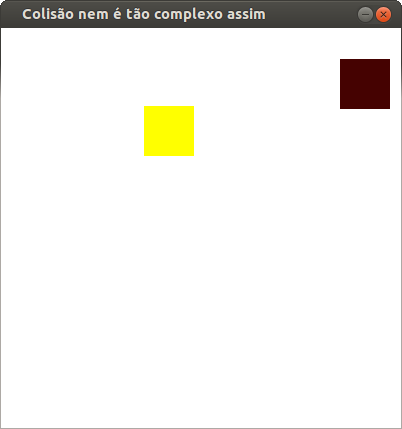Tutorial OpenGL v2.0
Finalmente chegou! Após quase 1 ano depois de meu primeiro artigo sobre OpenGL, chegou a versão 2.0. Clique e fique mais Geek.
[ Hits: 20.220 ]
Por: Thiago Henrique Hüpner em 08/05/2015
A jornada é longa parte 2 - Colisão entre 2 Retângulos
O exemplo ficou meio "tosco", mas tem como ter uma ideia de como funciona.
Aquele rolo de salvar e compilar você já sabe, então, vou pular essa parte:
#include <SDL/SDL.h>
#include <SDL/SDL_opengl.h>
#include <time.h>
#define LARGURA 400
#define ALTURA 400
int colisao(SDL_Rect a,SDL_Rect b){
if(a.x <= b.x+b.w && a.x+a.w >= b.x){
if(a.y <= b.y+b.h && a.y+a.h >= b.y){
return 1;
}
}
// Se passou pelos if's e não retornou significa que não houve colisao
return 0;
}
void inicializaOpenGL(){
glClearColor(255,255,255,1);
glMatrixMode(GL_PROJECTION);
glLoadIdentity();
gluOrtho2D(0,LARGURA,ALTURA,0);
glMatrixMode(GL_MODELVIEW);
glClear(GL_COLOR_BUFFER_BIT);
}
// Simulando o SDL_FillRect
void GL_FillRect(SDL_Rect a,int r,int g,int b){
glLoadIdentity();
glColor3ub(r,g,b);
glBegin(GL_QUADS);
// Lado Superior Esquerdo
glVertex2f(a.x,a.y);
// Lado Superior Direito
glVertex2f(a.x+a.w,a.y);
// Lado Inferior Direito
glVertex2f(a.x+a.w,a.y+a.h);
// Lado Inferior Esquerdo
glVertex2f(a.x,a.y+a.h);
glEnd();
}
int main(int argc,char *argv[]){
if(SDL_Init(SDL_INIT_VIDEO) < 0){
// ... imprima a mensagem de erro e ...
printf("Erro : %s
",SDL_GetError());
return -1;
}
// Para sempre ter valores pseudo-aleatorios
srand((unsigned)time(NULL));
SDL_GL_SetAttribute( SDL_GL_RED_SIZE, 8 );
SDL_GL_SetAttribute( SDL_GL_GREEN_SIZE, 8 );
SDL_GL_SetAttribute( SDL_GL_BLUE_SIZE, 8 );
SDL_GL_SetAttribute( SDL_GL_ALPHA_SIZE, 8 );
SDL_GL_SetAttribute( SDL_GL_DOUBLEBUFFER, 2 );
SDL_Surface * tela = SDL_SetVideoMode(LARGURA,ALTURA,32,SDL_OPENGL);
if(tela == NULL){
printf("Erro : %s
",SDL_GetError());
SDL_Quit();
return -1;
}
SDL_WM_SetCaption("Colisão nem é tão complexo assim",NULL);
SDL_Event evento;
int estaRodando = 1;
SDL_Rect retangulo,r2;
inicializaOpenGL();
int r = 255;
int g = 0;
int b = 0;
int posX = 100;
int posY = 100;
int aux1 = 10;
int aux2 = 10;
while(estaRodando){
while(SDL_PollEvent(&evento)){
switch(evento.type){
case SDL_QUIT:
estaRodando = 0;
break;
case SDL_MOUSEMOTION:
posX = evento.motion.x;
posY = evento.motion.y;
if(colisao(retangulo,r2)){
// Muda a cor R,G e B e consequentemente a cor do retangulo muda
// NOTA : Tem que ser 256 e não 256 , pois a chance de ser 255 é muito pequena e usando o 256 , a chance aumenta
// de ser 255
r = rand() % 256;
g = rand() % 256;
b = rand() % 256;
// Posicao aleatoria
aux1 = rand() % (LARGURA - retangulo.w);
aux2 = rand() % (ALTURA - retangulo.h);
}
break;
default:
break;
}
}
retangulo.x = aux1;
retangulo.y = aux2;
retangulo.w = 50;
retangulo.h = 50;
r2.x = posX;
r2.y = posY;
r2.w = 50;
r2.h = 50;
// Desta vez limpo a tela aqui e não no GL_FillRect, pois pode haver conflito
//de um retangulo aparecer e outro não
glClear(GL_COLOR_BUFFER_BIT);
GL_FillRect(retangulo,r,g,b);
GL_FillRect(r2,255,255,0);
SDL_Delay(30);
SDL_GL_SwapBuffers();
}
SDL_Quit();
return 0;
}
Veja como ficou (após ter brincado um pouco...):

Ele troca a cor do retângulo (retângulo) colide com o segundo retângulo(r2), e o primeiro retângulo vai para um outro lugar da tela.
Mas como funciona a colisão?
Bom, vamos por partes.
Ele verifica primeiro se colidiu o eixo x com 2 verificações:
- a.x <= b.x+b.w[ate aki] && a.x+a.w >= b.x, ou com outras palavras , "A posição X do Retangulo A é Menor ou Igual a Posição X incrementada da Largura do Retangulo B"?
- a.x <= b.x+b.w && [italico]a.x+a.w >= b.x, ou com outras palavras, "O Retangulo A incrementado da Largura dele é maior ou igual a posição X do Retangulo B"?
É o mesmo conceito para o eixo y, mas utilizando a altura em vez de largura. Deixo como desafio, tentar fazer um joguinho simples de pegar retângulos caindo (tipo o "pega-maçã").
2. Inicializando o SDL
3. OpenGL e SDL botando pra quebrar
4. Simulando uma Gambiarra
5. A jornada é longa parte 1 - Colisão Mouse e Retângulo
6. A jornada é longa parte 2 - Colisão entre 2 Retângulos
7. "Imagine" seu programa
8. Agradecimentos, links úteis e fontes
Ubuntu/Debian/Kali Linux e outros no Android
Como aprender a programar e produzir aplicativos usando Euphoria
Detectando assalto na multidão com visão computacional
Aprendendo a utilizar o GNU Debugger (parte 1)
Muito bom! Vou tentar criar um game simples pra minha filha ficar clicando no retângulo com a cor certa com base neste tutorial.
[1] Comentário enviado por fabio em 08/05/2015 - 10:30h
Muito bom! Vou tentar criar um game simples pra minha filha ficar clicando no retângulo com a cor certa com base neste tutorial.
Fábio, mais uma vez, muito obrigado !
E boa sorte com o aplicativo, espero que sua filha goste.
Qualquer dúvida só pedir =D
[]'s
T+
Bom artigo!
Favoritado e pega meu 10!
Até
[3] Comentário enviado por UmCaraAToa em 08/05/2015 - 11:25h
Bom artigo!
Favoritado e pega meu 10!
Até
Valeu fera
T+
Favoritado. Vou ler depois com calma. Mas só de dar uma olhada por rápida vi que é material interessante!
--
http://pastebin.com/aji5Qp05
[5] Comentário enviado por xerxeslins em 08/05/2015 - 11:49h
Favoritado. Vou ler depois com calma. Mas só de dar uma olhada por rápida vi que é material interessante!
--
http://pastebin.com/aji5Qp05
Valeu fera, Obrigado!
[]'s
T+
Parabéns pelo artigo escrito, é uns dos melhores (e únicos) artigos sobre OpenGL aqui no VOL.
[7] Comentário enviado por preroeb em 08/05/2015 - 19:02h
Parabéns pelo artigo escrito, é uns dos melhores (e únicos) artigos sobre OpenGL aqui no VOL.
Valew pela força!
Dando duro pra trazer um artigo de qualidade pra vocês, meu povinho do "Volzinho"!
[]'s
T+
Ae Parabéns brother excelente artigo , favoritado aqui tbm :)
Igor Felipe
Cadastrado desde: 25/09/2009
[b]If it moves , compile it.[/b]
[9] Comentário enviado por Felipeigor em 08/05/2015 - 19:43h
Ae Parabéns brother excelente artigo , favoritado aqui tbm :)
Igor Felipe
Cadastrado desde: 25/09/2009
[b]If it moves , compile it.[/b]
Valew Tambem pelo apoio!
[]'s
T+
Legal cara, bem explicada a parte sobre colisão. Um bom artigo como um todo. Parabéns.
[11] Comentário enviado por SamL em 09/05/2015 - 12:50h
Legal cara, bem explicada a parte sobre colisão. Um bom artigo como um todo. Parabéns.
Valew Sam! Sempre me apoiando!
[]'s
T+
Oi, Thiago!
Dei uma rápida lida no seu artigo.
Está muito bom!
Continue assim, com essas ótimas contribuições!
Ang,
Manaus, AM, Brasil.
Usuário de sistemas operacionais livres/abertos tipo Unix ou tipo DOS,
Distros Favoritas: FreeBSD, Free-DOS, , PC-DOS, Bodhi Linux, Ubuntu, Big Linux, Kurumim, OpenSUSE, Slackware e Slax.
[13] Comentário enviado por Ang em 09/05/2015 - 16:14h
Oi, Thiago!
Dei uma rápida lida no seu artigo.
Está muito bom!
Continue assim, com essas ótimas contribuições!
Ang,
Manaus, AM, Brasil.
Usuário de sistemas operacionais livres/abertos tipo Unix ou tipo DOS,
Distros Favoritas: FreeBSD, Free-DOS, , PC-DOS, Bodhi Linux, Ubuntu, Big Linux, Kurumim, OpenSUSE, Slackware e Slax.
Valew !
Obrigado por ter lido!
[]'s
T+
Patrocínio
Destaques
Artigos
Cirurgia para acelerar o openSUSE em HD externo via USB
Void Server como Domain Control
Modo Simples de Baixar e Usar o bash-completion
Monitorando o Preço do Bitcoin ou sua Cripto Favorita em Tempo Real com um Widget Flutuante
Dicas
Como fazer a conversão binária e aplicar as restrições no Linux
Como quebrar a senha de um servidor Linux Debian
Como bloquear pendrive em uma rede Linux
Um autoinstall.yaml para Ubuntu com foco em quem vai fazer máquina virtual
Instalar GRUB sem archinstall no Arch Linux em UEFI Problemático
Tópicos
Formas seguras de instalar Debian Sid (13)
Malware encontrado em extensões do Firefox. (0)
Fiz uma pergunta no fórum mas não consigo localizar [RESOLVIDO] (21)
Top 10 do mês
-

Xerxes
1° lugar - 150.437 pts -

Fábio Berbert de Paula
2° lugar - 69.214 pts -

Mauricio Ferrari
3° lugar - 21.854 pts -

Buckminster
4° lugar - 21.378 pts -

Alberto Federman Neto.
5° lugar - 20.676 pts -

edps
6° lugar - 19.650 pts -

Daniel Lara Souza
7° lugar - 19.022 pts -

Andre (pinduvoz)
8° lugar - 17.525 pts -

Alessandro de Oliveira Faria (A.K.A. CABELO)
9° lugar - 16.314 pts -

Diego Mendes Rodrigues
10° lugar - 14.569 pts




